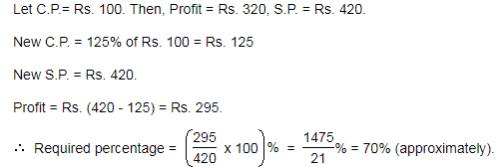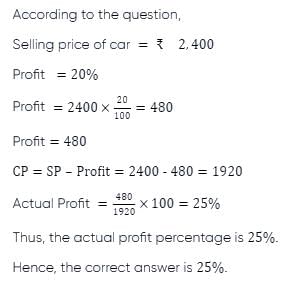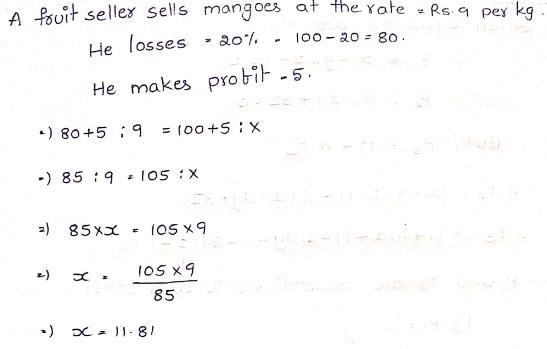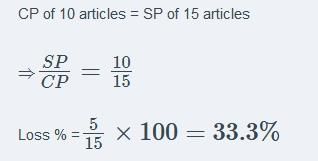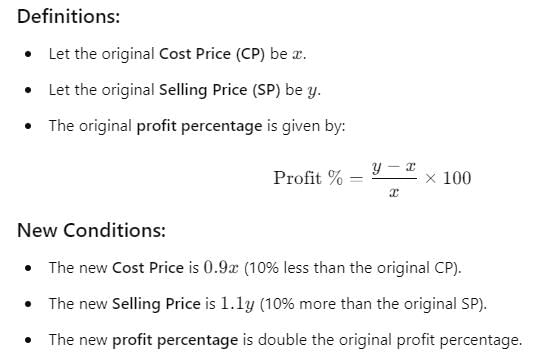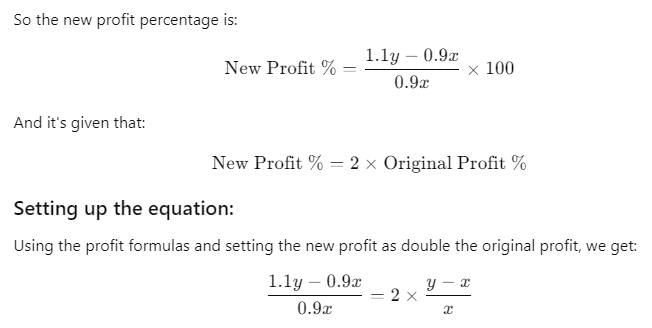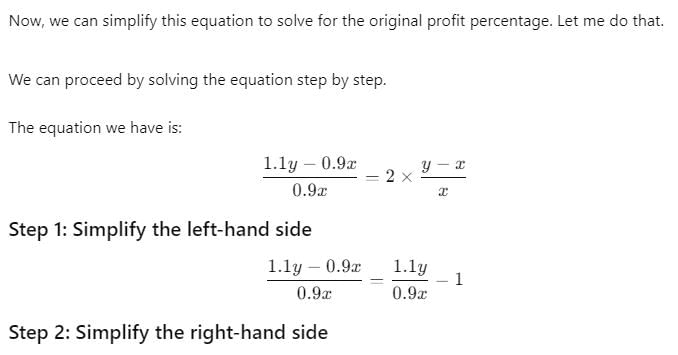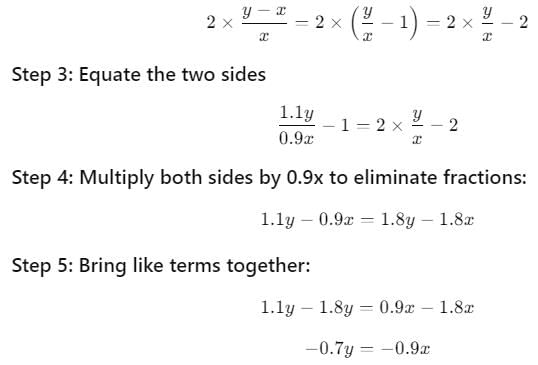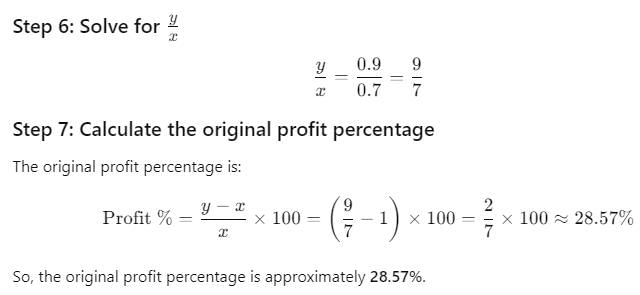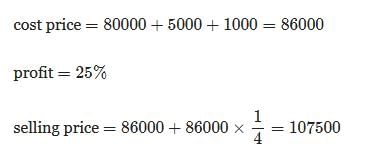All Exams >
Interview Preparation >
Quantitative Aptitude (Quant) >
All Questions
All questions of Profit, Loss and Discount for Interview Preparation Exam
A sells a car to B at 10% loss. If B sells it for Rs. 54000 and gains 20%, the cost price of the car for A was
a)Rs. 25000
b)Rs. 50000
c)Rs. 37500
d)Rs. 60000
Correct answer is option 'B'. Can you explain this answer?
|
|
Gaurav Datta answered |
Selling price of the car = Rs.54,000
gain 20%
Friend's cost price of the car = Rs. 54000 x 100/120 = Rs.45,000
Now selling price of the car of the first owner Rs.45000
Loss 10%
Cost price of the car = 45000 x 100/90
= Rs.50,000
gain 20%
Friend's cost price of the car = Rs. 54000 x 100/120 = Rs.45,000
Now selling price of the car of the first owner Rs.45000
Loss 10%
Cost price of the car = 45000 x 100/90
= Rs.50,000
If a material is sold for Rs.34.80, there is a loss of 25%. Find out the cost price of the material?
- a)Rs.46.40
- b)Rs.44
- c)Rs.42
- d)Rs.47.20
Correct answer is option 'A'. Can you explain this answer?
If a material is sold for Rs.34.80, there is a loss of 25%. Find out the cost price of the material?
a)
Rs.46.40
b)
Rs.44
c)
Rs.42
d)
Rs.47.20

|
EduRev CAT answered |
The correct answer is A as
cost price
=34.80×100/75
=46.40
cost price
=34.80×100/75
=46.40
A dishonest dealer marks up the price of his goods by 20% and gives a discount of 10% to the customer. Besides, he also cheats both his supplier and his buyer by 100 grams while buying or selling 1 kilogram. Find the percentage profit earned by the shopkeeper.
- a)20%
- b)25%
- c)27.5%
- d)32%
Correct answer is option 'D'. Can you explain this answer?
A dishonest dealer marks up the price of his goods by 20% and gives a discount of 10% to the customer. Besides, he also cheats both his supplier and his buyer by 100 grams while buying or selling 1 kilogram. Find the percentage profit earned by the shopkeeper.
a)
20%
b)
25%
c)
27.5%
d)
32%

|
Arya Roy answered |
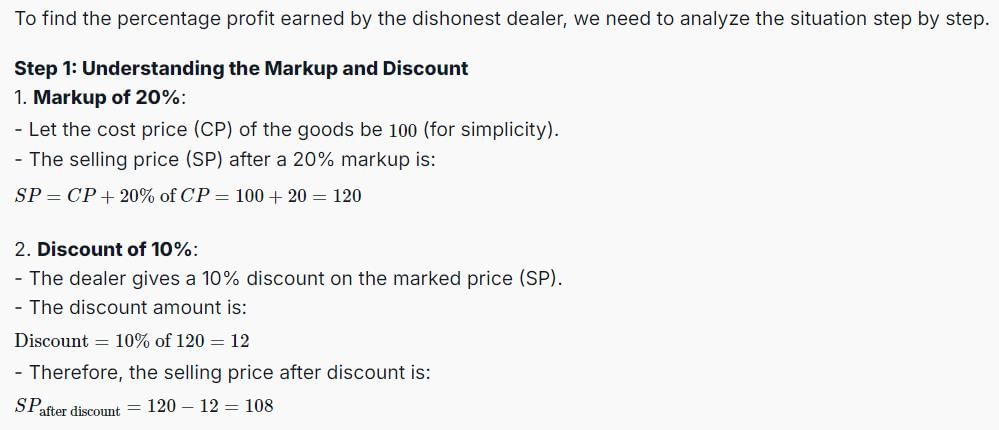
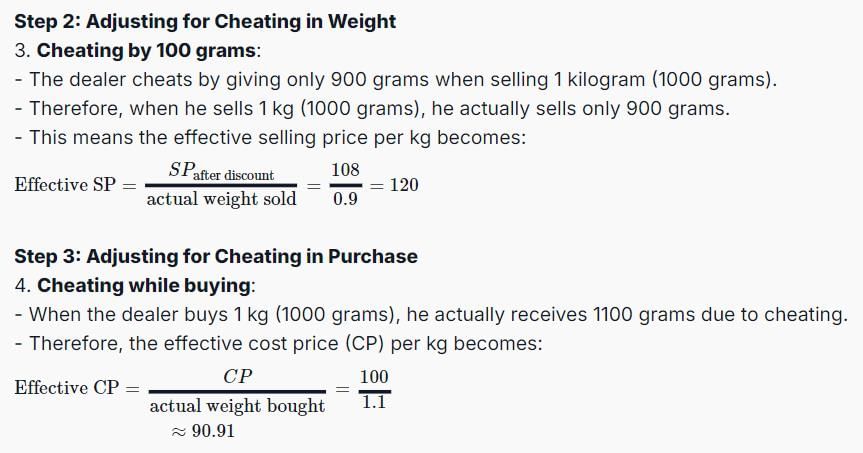
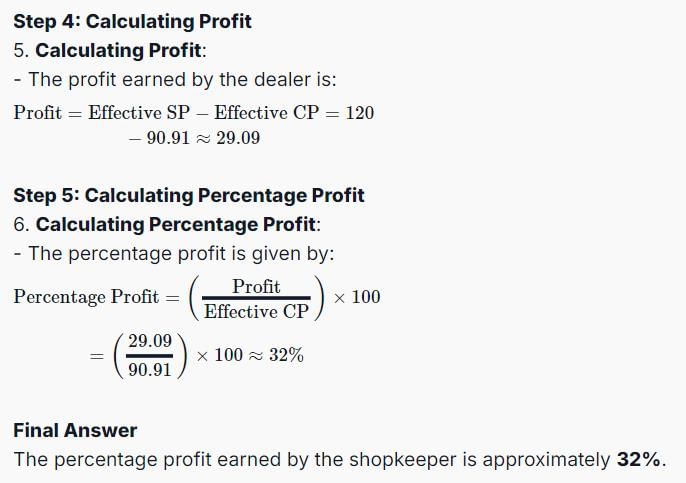
A shopkeeper purchases his goods at a discount of ... more10% on the list price. He normally gives a discount of 6% to his customers. If during a special scheme, he gets an additional discount of 2% on his purchase price, find his approximate profit percentage.a)8.8%b)7.8%c)6.6%d)None of theseCorrect answer is option 'C'. Can you explain this answer?
|
|
Aisha Gupta answered |

John buys an old scooter for Rs. 4700 and spends Rs. 800 on its repairs. If he sells the scooter for Rs. 5800, what is his gain percent ?
- a)12%
- b)10%
- c)4 + 4 / 7%
- d)5 + 5 / 11%
Correct answer is option 'D'. Can you explain this answer?
John buys an old scooter for Rs. 4700 and spends Rs. 800 on its repairs. If he sells the scooter for Rs. 5800, what is his gain percent ?
a)
12%
b)
10%
c)
4 + 4 / 7%
d)
5 + 5 / 11%
|
|
Milan Chaudhary answered |
Whenever we get this type of question, we should have formula in mind that,
Gain% = (gain/cost) x 100
Cost = 4700 + 800 = Rs. 5500
S.P. = Rs. 5800
Profit = 5800 - 5500 = 300
Gain% = (gain/cost) x 100
Cost = 4700 + 800 = Rs. 5500
S.P. = Rs. 5800
Profit = 5800 - 5500 = 300

A shopkeeper professes to sell his articles at CP but gives only N grams in the place of 1000 gm. If his profit percentage is 100%, what is the value of N?- a)750
- b)500
- c)0
- d)Not possible
Correct answer is option 'B'. Can you explain this answer?
A shopkeeper professes to sell his articles at CP but gives only N grams in the place of 1000 gm. If his profit percentage is 100%, what is the value of N?
a)
750
b)
500
c)
0
d)
Not possible

|
Chanchal Vaishnav answered |
B
(error÷1000-error)×100=1
0
(X/1000-x)×100= 100
100x= 100×(1000-x)
100x= 100000-100x
200x= 100000
X= 100000/200
X= 500
so error is 500 then N= 1000-500=500
Sunny marks up his goods by 40% and gives a discount of 10%. Apart from this, he uses a faulty balance which reads 800 gms for 1000 gms. What is his net profit/ loss percentage?- a)37.5%
- b)57.2%
- c)8%
- d)None of these
Correct answer is option 'A'. Can you explain this answer?
Sunny marks up his goods by 40% and gives a discount of 10%. Apart from this, he uses a faulty balance which reads 800 gms for 1000 gms. What is his net profit/ loss percentage?
a)
37.5%
b)
57.2%
c)
8%
d)
None of these
|
|
Ravi Singh answered |
Since he sells the goods at a discount the selling price will be (40% - 10%) = 30% profit.
The profit is 30%.
Lets take the buying price as x.
The profit on the 1000g rather 1 kg will be 30% of x.
This gives us 0.3x
In reality this is the profit for 800 g.
The profit he gets for 1000g will be :
1000/800 × 0.3x = 0.375x
To change this to percentage it becomes :
0.375x/x × 100% = 37.5
The overall percentage profit gained by the seller will be given as : 37.5%
A man sells a TV set for Rs. 33000 and makes a profit of 10%. He sells another TV at a loss of 20%. If on the whole, he neither gains nor loses, find the selling price of the second TV set.
- a)Rs.15,000
- b)Rs.30,000
- c)Rs.12,000
- d)Rs.27,000
Correct answer is option 'C'. Can you explain this answer?
A man sells a TV set for Rs. 33000 and makes a profit of 10%. He sells another TV at a loss of 20%. If on the whole, he neither gains nor loses, find the selling price of the second TV set.
a)
Rs.15,000
b)
Rs.30,000
c)
Rs.12,000
d)
Rs.27,000
|
|
Aarav Sharma answered |
Given:
Selling price of first TV set = Rs. 33000
Profit earned on first TV set = 10%
To find: Selling price of the second TV set
Let's assume the cost price of the first TV set = x
Profit earned on the first TV set = 10%
Therefore, selling price of the first TV set = x + 0.1x = 1.1x
Selling price of the first TV set = Rs. 33000
So, 1.1x = 33000
x = 30000
Cost price of the second TV set = y
Loss incurred on the second TV set = 20%
Therefore, selling price of the second TV set = y - 0.2y = 0.8y
Now, let's assume that the man sells the second TV set at a selling price of z.
Total selling price of both the TV sets = 33000 + z
Total cost price of both the TV sets = 30000 + y
It is given that the man neither gains nor loses on the whole, i.e., total selling price = total cost price
33000 + z = 30000 + y + 0.8y
33000 + z = 38000 + 0.8y
z = 38000 - 0.8y
Substituting the value of z in the above equation, we get:
33000 + 38000 - 0.8y = 30000 + y
71000 - 0.8y = 30000 + y
71000 = 1.8y
y = 71000/1.8
y = 39444.44
Selling price of the second TV set = 0.8y = 0.8 x 39444.44 = Rs. 31555.56
Therefore, option (c) Rs. 27,000 is incorrect and the correct answer is option (a) Rs. 15,000.
Selling price of first TV set = Rs. 33000
Profit earned on first TV set = 10%
To find: Selling price of the second TV set
Let's assume the cost price of the first TV set = x
Profit earned on the first TV set = 10%
Therefore, selling price of the first TV set = x + 0.1x = 1.1x
Selling price of the first TV set = Rs. 33000
So, 1.1x = 33000
x = 30000
Cost price of the second TV set = y
Loss incurred on the second TV set = 20%
Therefore, selling price of the second TV set = y - 0.2y = 0.8y
Now, let's assume that the man sells the second TV set at a selling price of z.
Total selling price of both the TV sets = 33000 + z
Total cost price of both the TV sets = 30000 + y
It is given that the man neither gains nor loses on the whole, i.e., total selling price = total cost price
33000 + z = 30000 + y + 0.8y
33000 + z = 38000 + 0.8y
z = 38000 - 0.8y
Substituting the value of z in the above equation, we get:
33000 + 38000 - 0.8y = 30000 + y
71000 - 0.8y = 30000 + y
71000 = 1.8y
y = 71000/1.8
y = 39444.44
Selling price of the second TV set = 0.8y = 0.8 x 39444.44 = Rs. 31555.56
Therefore, option (c) Rs. 27,000 is incorrect and the correct answer is option (a) Rs. 15,000.
A shopkeeper purchases a packet of 50 pens at Rs 1... more0 per pen. He sells a part of the packet at a profit of 30%. On the remaining part, he incurs a loss of 10%. If his overall profit on the whole packet is 10%, the number of pens he sold at profit isa)25b)30c)20d)15Correct answer is option 'A'. Can you explain this answer?

|
Naroj Boda answered |
E sold at table to R at a profit of 25%.R sold the same table to S for Rs. 90 thereby making a profit of 20%. Find the price at which E bought the table from Z if it is known that Z gained 25% in the transaction.
- a)Rs.80
- b)Rs.75
- c)Rs.90
- d)Rs.60
Correct answer is option 'D'. Can you explain this answer?
E sold at table to R at a profit of 25%.R sold the same table to S for Rs. 90 thereby making a profit of 20%. Find the price at which E bought the table from Z if it is known that Z gained 25% in the transaction.
a)
Rs.80
b)
Rs.75
c)
Rs.90
d)
Rs.60
|
|
Ritika Choudhury answered |
R sold the table at 20% profit at Rs. 90. Thus cost price would be given by: CPR X 1.2 = 90
R’s Cost price = Rs. 75.
We also know that E sold it to R at 25% profit. Thus,
E’s Cost price X 1.25 = 75
-> E’s cost price = 60.
R’s Cost price = Rs. 75.
We also know that E sold it to R at 25% profit. Thus,
E’s Cost price X 1.25 = 75
-> E’s cost price = 60.
A man buys 200 oranges for Rs 10. How many oranges a rupee can he sell so that his profit percentage is 25%?- a)10
- b)14
- c)16
- d)20
Correct answer is option 'C'. Can you explain this answer?
A man buys 200 oranges for Rs 10. How many oranges a rupee can he sell so that his profit percentage is 25%?
a)
10
b)
14
c)
16
d)
20
|
|
Preeti Khanna answered |
So, he should sell 16 oranges in a rupee to make a profit of 25%.
A man sold an article at a profit of 10%. If he had charged Rs 45 more his profit percentage would have been 25%. What is the cost price?- a)Rs 200
- b)Rs 300
- c)Rs 250
- d)None of these
Correct answer is option 'B'. Can you explain this answer?
A man sold an article at a profit of 10%. If he had charged Rs 45 more his profit percentage would have been 25%. What is the cost price?
a)
Rs 200
b)
Rs 300
c)
Rs 250
d)
None of these

|
Pallabi Deshpande answered |
Profit%= 10%
SP= CP+ (10/100)*CP = 11CP/10.
Now if he had sold it for RS.45 more, profit% given is 25%.
SP+45= CP + (25/100)*CP
SP + 45= 5CP/4
Substitute SP = 11 CP/10 in the above equation.
You get CP = RS. 300
On selling 17 balls at Rs. 720, there is a loss equal to the cost price of 5 balls. What is the cost price of a ball?
- a)Rs. 43
- b)Rs. 60
- c)Rs. 55
- d)Rs. 34
Correct answer is option 'B'. Can you explain this answer?
a)
Rs. 43
b)
Rs. 60
c)
Rs. 55
d)
Rs. 34
|
|
Alok Verma answered |
Let the cost price of a ball be Rs. x.
So, the CP of 17 balls is Rs. 17x.
The CP of 5 balls is Rs. 5x.
Since Loss = CP - SP
So, 5x = 17x - 720
On solving, we get
12 x = 720
that is, x = 60
So, the cost price of a ball is Rs. 60.
Murali purchased 20 dozens of toys at the rate of Rs. 375 per dozen. He sold each one of them at the rate of Rs. 33. Find out his profit percentage.- a)3.5
- b)5.6
- c)4.1
- d)3.4
Correct answer is 'B'. Can you explain this answer?
Murali purchased 20 dozens of toys at the rate of Rs. 375 per dozen. He sold each one of them at the rate of Rs. 33. Find out his profit percentage.
a)
3.5
b)
5.6
c)
4.1
d)
3.4

|
Gowri Chakraborty answered |
The cost price of 20 dozens of toys = 375*20 i.e per dozen 375= Rs 7500/-the selling price of one dozen toys = 12*33= Rs 396/-the selling price of 20 dozen toys = 396*20= Rs 7920/-gain=sp-cp = 7920-7500 =Rs.420/-gain%=(gain/cp)*100 = 420/7500*100 =5.6%
A vendor bought bananas at 6 for a rupee. How many for a rupee must he sell to gain 20%?
- a)3
- b)4
- c)5
- d)6
Correct answer is 'C'. Can you explain this answer?
a)
3
b)
4
c)
5
d)
6

|
Pallabi Deshpande answered |
Go through this doc which will help you understand the basic concepts of profit, loss, and discount for CAT exam.
While I was shopping in Kamla Nagar market for my baby girl Tatto, I came across two shopkeepers who were giving me a discount of same amount for a top. While first shopkeeper was offering a discount of 14.28%, second shopkeeper was offering a discount of 12.5% over their respective mark-ups. Whose cost price is higher?
- a)1st shopkeeper
- b)2nd shopkeeper
- c)Either of them depending upon their respective MP
- d)Cannot be determined
Correct answer is option 'D'. Can you explain this answer?
While I was shopping in Kamla Nagar market for my baby girl Tatto, I came across two shopkeepers who were giving me a discount of same amount for a top. While first shopkeeper was offering a discount of 14.28%, second shopkeeper was offering a discount of 12.5% over their respective mark-ups. Whose cost price is higher?
a)
1st shopkeeper
b)
2nd shopkeeper
c)
Either of them depending upon their respective MP
d)
Cannot be determined

|
Ankita Singh answered |
According to the information given in the question,
While the first shopkeeper was offering a discount of 14.28%, the second shopkeeper was offering a discount of 12.5% over their respective mark-ups.
We need to find a shopkeeper whose cost price is higher.
After analyzing the given statement, we get that
14.28% of mark-up of the first shopkeeper =12.5% of mark-up of the second shopkeeper.
With this given information, we can compare the mark-up price, whereas nothing can be said about the cost prices of the shopkeepers.
Hence, the correct answer is "cannot be determined".
An article is bought for Rs 600 and sold for Rs 750. What is the profit percentage?- a)20%
- b)25%
- c)30%
- d)None of these
Correct answer is option 'B'. Can you explain this answer?
An article is bought for Rs 600 and sold for Rs 750. What is the profit percentage?
a)
20%
b)
25%
c)
30%
d)
None of these

|
Arya Roy answered |
Total Profit = 750 - 600 = 150 rs
Percentage of Profit = 150/600 = 25%
Hence he makes 25% profit on his investment/ principal amount.
Read the passage below and solve the questions based on it, Patna-mart, sister concern of Wal-marL is planning to establish a mechanism to give discount, it is actually a Kind Ja Simsim kind of game where if you win any round, you will gel some discount specific to dial round, and it you lose, you will be losing al! the discounts so far won.
Now, round l is hav ing discount coupons of 2%.
Round 2 is having discount coupons of 4%.
Round 3 is having discount coupons of 6%, And so on...............
There are infinite round sand you can participate in all the rounds but you can participate in any round only once and before participating in round N (any particular round), you should have participated in round 1 - round N -1 (all die rounds before that particular round.) All the discounts won will be successive, eg., if you win Round 1 and then round 2 also, you will get a successive discount of 2% and then 4%. But again as the rule goes on. if you lose round 3, you will be losing ail the discount coupons won so far Bui despite losing round 3, you can participate in round 4 and hence.Q.What is the minimum number of rounds to obtain maximum possible discount?- a)50
- b)100
- c)Infinite
- d)Cannot be determined
Correct answer is option 'A'. Can you explain this answer?
Read the passage below and solve the questions based on it, Patna-mart, sister concern of Wal-marL is planning to establish a mechanism to give discount, it is actually a Kind Ja Simsim kind of game where if you win any round, you will gel some discount specific to dial round, and it you lose, you will be losing al! the discounts so far won.
Now, round l is hav ing discount coupons of 2%.
Round 2 is having discount coupons of 4%.
Round 3 is having discount coupons of 6%, And so on...............
There are infinite round sand you can participate in all the rounds but you can participate in any round only once and before participating in round N (any particular round), you should have participated in round 1 - round N -1 (all die rounds before that particular round.) All the discounts won will be successive, eg., if you win Round 1 and then round 2 also, you will get a successive discount of 2% and then 4%. But again as the rule goes on. if you lose round 3, you will be losing ail the discount coupons won so far Bui despite losing round 3, you can participate in round 4 and hence.
Now, round l is hav ing discount coupons of 2%.
Round 2 is having discount coupons of 4%.
Round 3 is having discount coupons of 6%, And so on...............
There are infinite round sand you can participate in all the rounds but you can participate in any round only once and before participating in round N (any particular round), you should have participated in round 1 - round N -1 (all die rounds before that particular round.) All the discounts won will be successive, eg., if you win Round 1 and then round 2 also, you will get a successive discount of 2% and then 4%. But again as the rule goes on. if you lose round 3, you will be losing ail the discount coupons won so far Bui despite losing round 3, you can participate in round 4 and hence.
Q.
What is the minimum number of rounds to obtain maximum possible discount?
a)
50
b)
100
c)
Infinite
d)
Cannot be determined
|
|
Anaya Patel answered |
Maximum possible discount in any case can be only 100% and any discount more than 100% is actually 100% only. Now, whatever is the discount, till the moment we get a discount of 100%, value of the article cannot be zero (even infinite discounts of 99.99% won’t make it equal to a discount of 100%) So, number of rounds needed to obtain 100% discount = 50.
A man sells an article at 10% above its cost price. If he had bought it at 15% less than what he paid for it and sold it for Rs. 33 less, he would have gained 10%. Find the cost price of the article.- a)Rs.400
- b)Rs.200
- c)Rs.325
- d)Rs.260
Correct answer is option 'B'. Can you explain this answer?
A man sells an article at 10% above its cost price. If he had bought it at 15% less than what he paid for it and sold it for Rs. 33 less, he would have gained 10%. Find the cost price of the article.
a)
Rs.400
b)
Rs.200
c)
Rs.325
d)
Rs.260

|
Surbhi Joshi answered |
Given:
Selling price = Cost price + 10% of cost price
Let the cost price be x
Selling price = 1.1x
To find:
Cost price of the article
Solution:
Let the original selling price be y
The cost price of the article if he had bought it at 15% less than what he paid for it = 0.85y
He sold it for Rs. 33 less, so the selling price = y - 33
He gained 10%
Selling price = Cost price + 10% of cost price
1.1x = 1.1(0.85y) + 0.1(0.85y)
1.1x = 0.935y + 0.085y
1.1x = 1.02y
y = 1.078x
Substituting the value of y in the equation y - 33 = 1.1(0.85y)
1.078x - 33 = 0.935y
1.078x - 33 = 0.935(1.078x)
1.078x - 33 = 1.00883x
0.06917x = 33
x = 33/0.06917
x = Rs. 476.86
Therefore, the cost price of the article is Rs. 476.86
But, the options given are not in decimals
So, the closest option to Rs. 476.86 is Rs. 200
Hence, the correct option is (B) Rs. 200.
Selling price = Cost price + 10% of cost price
Let the cost price be x
Selling price = 1.1x
To find:
Cost price of the article
Solution:
Let the original selling price be y
The cost price of the article if he had bought it at 15% less than what he paid for it = 0.85y
He sold it for Rs. 33 less, so the selling price = y - 33
He gained 10%
Selling price = Cost price + 10% of cost price
1.1x = 1.1(0.85y) + 0.1(0.85y)
1.1x = 0.935y + 0.085y
1.1x = 1.02y
y = 1.078x
Substituting the value of y in the equation y - 33 = 1.1(0.85y)
1.078x - 33 = 0.935y
1.078x - 33 = 0.935(1.078x)
1.078x - 33 = 1.00883x
0.06917x = 33
x = 33/0.06917
x = Rs. 476.86
Therefore, the cost price of the article is Rs. 476.86
But, the options given are not in decimals
So, the closest option to Rs. 476.86 is Rs. 200
Hence, the correct option is (B) Rs. 200.
Amilkman professes to sell milk at its CP only. But still he is making a profit of 20% since he has mixed some amount of water in the milk. What is the percentage of milk in the mixture?- a)80%
- b)83.33%
- c)75%
- d)66.66%
Correct answer is 'B'. Can you explain this answer?
Amilkman professes to sell milk at its CP only. But still he is making a profit of 20% since he has mixed some amount of water in the milk. What is the percentage of milk in the mixture?
a)
80%
b)
83.33%
c)
75%
d)
66.66%

|
Keerthana Choudhary answered |
Alternatively, if he has initially 10 L of milk, he must have made it 12 L of mixture to get a profit of 20% (since SP per litre = CP per litre). Hence out of 12 litres of mixture, 10 litres is milk and 2 litres is water.
A shopkeeper uses a “point of sales” software which prepares the bill for customers based on the number of units per unit. Both of the above are 2-digit numbers. While entering the data, he erroneously swaps the digits of both quantity of units and price. As a result, the closing stock balance is lowered by 72 units, and the sales value shown is Rs 1,368. How many units have actually been sold?- a)27
- b)91
- c)83
- d)None of these
Correct answer is option 'B'. Can you explain this answer?
A shopkeeper uses a “point of sales” software which prepares the bill for customers based on the number of units per unit. Both of the above are 2-digit numbers. While entering the data, he erroneously swaps the digits of both quantity of units and price. As a result, the closing stock balance is lowered by 72 units, and the sales value shown is Rs 1,368. How many units have actually been sold?
a)
27
b)
91
c)
83
d)
None of these

|
Target Study Academy answered |
9(x - y ) = 72, x - y = 8
Therefore, only possibility is 19 or 91.
Apublisher printed 3,000 copies of ‘Future Shock ’ at a cost of Rs 2,400. He gave 500 copies free to different philanthropic institutions. He allowed a discount of 25% on the published price and gave one copy free for every 25 copies bought at a time. He was able to sell all the copies in this manner. If the published price is Rs 3.25, then what is his overall gain or loss percentage in the whole transaction?- a)113%
- b)130%
- c)162%
- d)144%
Correct answer is option 'D'. Can you explain this answer?
Apublisher printed 3,000 copies of ‘Future Shock ’ at a cost of Rs 2,400. He gave 500 copies free to different philanthropic institutions. He allowed a discount of 25% on the published price and gave one copy free for every 25 copies bought at a time. He was able to sell all the copies in this manner. If the published price is Rs 3.25, then what is his overall gain or loss percentage in the whole transaction?
a)
113%
b)
130%
c)
162%
d)
144%

|
Cstoppers Instructors answered |
Cost Rs 2400
Published Price Rs 3.25
SP = 75/100 x 3.25 = Rs 2.4375
No. of free copy = (3000/25) = 120 + 500 = 620
So, total SP = 2380 x Rs 2.4375 = Rs 5801.25
Hence percentage gain = 5801.25 - 2400/2400 - 100 = 144%
An article when sold at 10% discount on the marked price gave a profit of Rs 70. What is the CP?- a)Rs 700
- b)Rs 350
- c)Rs 125
- d)Cannot be determined
Correct answer is option 'D'. Can you explain this answer?
An article when sold at 10% discount on the marked price gave a profit of Rs 70. What is the CP?
a)
Rs 700
b)
Rs 350
c)
Rs 125
d)
Cannot be determined

|
Sameer Rane answered |
Profit % = (( Profit )/ (Cost price))X100
Profit = Cost price - Selling price
Let cost price be x
So,
10 = (70/x)X100
x= (70 X 100)/10
x=7000
So,
The cost price of the item is 7000 rupees
The profit obtained by selling a book for Rs 56 is the same as the loss obtained by selling this book for Rs 42. What is the cost price of the book?- a)Rs 40
- b)Rs 50
- c)Rs 49
- d)None of these
Correct answer is option 'C'. Can you explain this answer?
The profit obtained by selling a book for Rs 56 is the same as the loss obtained by selling this book for Rs 42. What is the cost price of the book?
a)
Rs 40
b)
Rs 50
c)
Rs 49
d)
None of these

|
Target Study Academy answered |
Let us assume that the cost price = Rs X
56 - x = x - 42
2x = 98
Hence, x = 49
Santa Singh, the local fruit vendor, buys a certain number of oranges at Rs 7 a dozen and equal number at Rs 6 a dozen. He sells the oranges at Rs 7.50 a dozen and makes a profit of Rs 80. How many oranges does he buy?- a)20 dozens
- b)70 dozens
- c)80 dozens
- d)40 dozens
Correct answer is option 'C'. Can you explain this answer?
Santa Singh, the local fruit vendor, buys a certain number of oranges at Rs 7 a dozen and equal number at Rs 6 a dozen. He sells the oranges at Rs 7.50 a dozen and makes a profit of Rs 80. How many oranges does he buy?
a)
20 dozens
b)
70 dozens
c)
80 dozens
d)
40 dozens
|
|
Rajeev Kumar answered |
C.P. of 2 dozen oranges = Rs. (7 + 6) = Rs. 13.
S.P. of 2 dozen oranges = Rs. 7.5(2)= 15
If profit is Rs. 2,
oranges bought = 2 dozen.
If profit is Rs. 80,
oranges bought = (2/2 x 80) dozens = 80 dozens.
S.P. of 2 dozen oranges = Rs. 7.5(2)= 15
If profit is Rs. 2,
oranges bought = 2 dozen.
If profit is Rs. 80,
oranges bought = (2/2 x 80) dozens = 80 dozens.
A trader gives 12% additional discount on the discounted price, after giving an initial discount of 20% on the labeled price of an item. The final sale price of the item is Rs.704. Find out the labeled price?
- a)1000
- b)2000
- c)1200
- d)920
Correct answer is option 'A'. Can you explain this answer?
a)
1000
b)
2000
c)
1200
d)
920

|
Gowri Chakraborty answered |
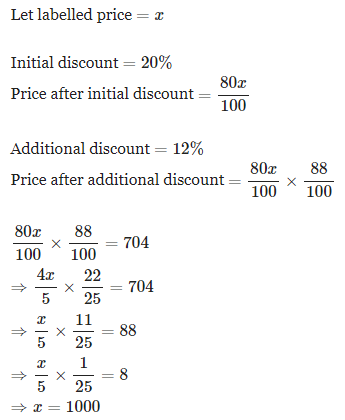
Anam bought a jute bag at 30% discount on the list price. He then sold it at a price which is 160% of the list price thereby making a profit of Rs 81. What is the list price of the bag?
- a)Rs 90
- b)Rs 100
- c)Rs 180
- d)Rs 200
Correct answer is option 'A'. Can you explain this answer?
Anam bought a jute bag at 30% discount on the list price. He then sold it at a price which is 160% of the list price thereby making a profit of Rs 81. What is the list price of the bag?
a)
Rs 90
b)
Rs 100
c)
Rs 180
d)
Rs 200

|
Bank Exams India answered |
Assume that MP = Rs 100
then CP of An am = Rs 70
and his SP = Rs 160
So, his Profit = Rs 90.
Now using unitary method, when profit of Anam = Rs 90, then his MP = 100. So when his MP = Rs 81, his MP = 90.
Now using unitary method, when profit of Anam = Rs 90, then his MP = 100. So when his MP = Rs 81, his MP = 90.
A supplier sells 20 pencils at the marked price of 16 pens to a retailer. The retailer, in turn, sells them at the marked price. What is the percentage profit or percentage loss of the retailer?- a)Loss 25%
- b)Profit 25%
- c)Loss 20%
- d)Profit 20%
Correct answer is option 'B'. Can you explain this answer?
A supplier sells 20 pencils at the marked price of 16 pens to a retailer. The retailer, in turn, sells them at the marked price. What is the percentage profit or percentage loss of the retailer?
a)
Loss 25%
b)
Profit 25%
c)
Loss 20%
d)
Profit 20%
|
|
Faizan Khan answered |

Navneet is a bananawallah who buys a gross of bananas at Rs 10 a dozen. During transport and storage two dozen bananas get spoilt. If Navneet spends 10% of his outlay on transport costs and wants an overall profit of 20%, at what price must he sell a dozen bananas?- a)Rs 14.64
- b)Rs 15.84
- c)Rs 16.24
- d)Rs 17.54
Correct answer is option 'B'. Can you explain this answer?
Navneet is a bananawallah who buys a gross of bananas at Rs 10 a dozen. During transport and storage two dozen bananas get spoilt. If Navneet spends 10% of his outlay on transport costs and wants an overall profit of 20%, at what price must he sell a dozen bananas?
a)
Rs 14.64
b)
Rs 15.84
c)
Rs 16.24
d)
Rs 17.54
|
|
Keerthana Yadav answered |
Two lots of oranges with equal quantity, one costing Rs 20 per dozen and the other costing Rs 30 per dozen, are mixed together and the whole lot is sold at Rs 24 per dozen. Then what is the profit or loss?- a)4% profit
- b)5.6% profit
- c)4% loss
- d)5.6% loss
Correct answer is option 'C'. Can you explain this answer?
Two lots of oranges with equal quantity, one costing Rs 20 per dozen and the other costing Rs 30 per dozen, are mixed together and the whole lot is sold at Rs 24 per dozen. Then what is the profit or loss?
a)
4% profit
b)
5.6% profit
c)
4% loss
d)
5.6% loss
|
|
Aryan Khanna answered |
When two doze are mixed togather
then cost price of both =20+30
=50
one dozen is sold at =rs 24
then two dozen are sold at =2�24
= 48rs
sp=48
cp = 50
loss = cp-sp
= 50-48
= 2rs
loss%= loss�100/cp
= 2�100/50
= 200/50
= 4%
then cost price of both =20+30
=50
one dozen is sold at =rs 24
then two dozen are sold at =2�24
= 48rs
sp=48
cp = 50
loss = cp-sp
= 50-48
= 2rs
loss%= loss�100/cp
= 2�100/50
= 200/50
= 4%
The owner of Book Point does not get either profit or loss by selling 15 books for Rs 225. How many books should he sell for the same amount to gain 25% profit?- a)10
- b)11
- c)12
- d)13
Correct answer is option 'C'. Can you explain this answer?
The owner of Book Point does not get either profit or loss by selling 15 books for Rs 225. How many books should he sell for the same amount to gain 25% profit?
a)
10
b)
11
c)
12
d)
13
|
|
Aarav Sharma answered |
Given:
Selling price of 15 books = Rs 225
No profit or loss
To Find:
Number of books to be sold to gain 25% profit
Solution:
Let the cost price of each book be x.
Total cost price of 15 books = 15x
Given, Selling price of 15 books = Rs 225
Therefore, selling price of each book = 225/15 = 15
Since there is no profit or loss,
Total cost price = Total selling price
15x * 15 = 225
x = 225/225
x = 1
So, the cost price of each book is Rs 1.
To gain 25% profit, the selling price should be 1.25 times the cost price.
Selling price of each book = 1.25
Let the number of books to be sold for the same amount be n.
Total selling price of n books = 15 (since selling price of 15 books is Rs 225)
Therefore, 1.25n = 225
n = 180/1.25
n = 144
Therefore, the owner should sell 12 books for the same amount to gain a 25% profit. Answer: (C)
Selling price of 15 books = Rs 225
No profit or loss
To Find:
Number of books to be sold to gain 25% profit
Solution:
Let the cost price of each book be x.
Total cost price of 15 books = 15x
Given, Selling price of 15 books = Rs 225
Therefore, selling price of each book = 225/15 = 15
Since there is no profit or loss,
Total cost price = Total selling price
15x * 15 = 225
x = 225/225
x = 1
So, the cost price of each book is Rs 1.
To gain 25% profit, the selling price should be 1.25 times the cost price.
Selling price of each book = 1.25
Let the number of books to be sold for the same amount be n.
Total selling price of n books = 15 (since selling price of 15 books is Rs 225)
Therefore, 1.25n = 225
n = 180/1.25
n = 144
Therefore, the owner should sell 12 books for the same amount to gain a 25% profit. Answer: (C)
A bookseller marks his books at an advance of 69% on the actual cost of production. He allows a discount of 15% and also given a copy free for every dozen sold at a time. What rate per cent profit does the bookseller make, if books are sold in lots of 12?- a)32.6
- b)47.5
- c)24.9
- d)None of these
Correct answer is option 'A'. Can you explain this answer?
A bookseller marks his books at an advance of 69% on the actual cost of production. He allows a discount of 15% and also given a copy free for every dozen sold at a time. What rate per cent profit does the bookseller make, if books are sold in lots of 12?
a)
32.6
b)
47.5
c)
24.9
d)
None of these

|
Divey Sethi answered |
The cost price of 20 articles is the same as the selling price of x articles. If the profit is 25%, find out the value of x
- a)15
- b)25
- c)18
- d)16
Correct answer is 'D'. Can you explain this answer?
a)
15
b)
25
c)
18
d)
16

|
Sameer Rane answered |
Let C.P. of each article be Re. 1 C.P. of x articles = Rs. x.S.P. of x articles = Rs. 20.Profit = Rs. (20 - x).because [(20 - x)/x] x 100 = 25=> 2000 - 100x = 25x=> 125x = 2000 x = 16.
A wholeseller supplies few chips to a retailer every year. Each chip costs Rs 10,000 to the wholeseller. 5% of the chips are defective and they are to be replaced without charging anything extra. If the wholeseller still makes a profit of 20%, at what price is he selling it to retailer?- a)Rs 12,300
- b)Rs 12,600
- c)Rs 13,200
- d)None of these
Correct answer is option 'B'. Can you explain this answer?
A wholeseller supplies few chips to a retailer every year. Each chip costs Rs 10,000 to the wholeseller. 5% of the chips are defective and they are to be replaced without charging anything extra. If the wholeseller still makes a profit of 20%, at what price is he selling it to retailer?
a)
Rs 12,300
b)
Rs 12,600
c)
Rs 13,200
d)
None of these
|
|
Yash Patel answered |
Let No. of chips supplied = 100
For whole seller, Net CP = (10000 x 100 + 5 x 10000) = Rs 1050000
Read the passage below and solve the questions based on it.
In the ' Gel-One'' supermarket, a new software was installed in the computerized billing section which made the calculations of each of the item sold very easy on the first day of the operations. To verify the workability of the software only one of the item was billed Oil the computer.
Due to some technical problem in the software, it reversed both the numbers of the item sold and price per piece as a result of which the closing of the slock items showed 63 items less and the value on the items still left was show n Rs 936.
It was known that both die slocks left and die price per piece are two digit numbers.Q.What is the correct collection for the day if 44 pieces were sold?- a)Rs 2,288
- b)Rs 1,744
- c)Rs 1,444
- d)None of these
Correct answer is option 'D'. Can you explain this answer?
Read the passage below and solve the questions based on it.
In the ' Gel-One'' supermarket, a new software was installed in the computerized billing section which made the calculations of each of the item sold very easy on the first day of the operations. To verify the workability of the software only one of the item was billed Oil the computer.
Due to some technical problem in the software, it reversed both the numbers of the item sold and price per piece as a result of which the closing of the slock items showed 63 items less and the value on the items still left was show n Rs 936.
It was known that both die slocks left and die price per piece are two digit numbers.
In the ' Gel-One'' supermarket, a new software was installed in the computerized billing section which made the calculations of each of the item sold very easy on the first day of the operations. To verify the workability of the software only one of the item was billed Oil the computer.
Due to some technical problem in the software, it reversed both the numbers of the item sold and price per piece as a result of which the closing of the slock items showed 63 items less and the value on the items still left was show n Rs 936.
It was known that both die slocks left and die price per piece are two digit numbers.
Q.
What is the correct collection for the day if 44 pieces were sold?
a)
Rs 2,288
b)
Rs 1,744
c)
Rs 1,444
d)
None of these
|
|
Ravi Singh answered |
Rate = 936/18= 52
It is given that price/piece was also reversed.
So, price/piece = Rs 25
Collection = Rs 25 x 44 = Rs 1100
Mohit goes to furniture shop to buy a sofa set and a center table. He bargains for a 10% discount on the center table and 25% discount on sofa set. However, the shopkeeper, by mistake, interchanged the discount percentage figures while making the bill and mohit paid accordingly. When compared to what he should pay for his purchases, what percentage did mohit pay extra given that the center table costs 40% as much as the sofa set.- a)12.3%
- b)7.2%
- c)8.1%
- d)6.3%
Correct answer is option 'C'. Can you explain this answer?
Mohit goes to furniture shop to buy a sofa set and a center table. He bargains for a 10% discount on the center table and 25% discount on sofa set. However, the shopkeeper, by mistake, interchanged the discount percentage figures while making the bill and mohit paid accordingly. When compared to what he should pay for his purchases, what percentage did mohit pay extra given that the center table costs 40% as much as the sofa set.
a)
12.3%
b)
7.2%
c)
8.1%
d)
6.3%
|
|
Aisha Gupta answered |

Read the passage below and solve the questions based on it, Patna-mart, sister concern of Wal-marL is planning to establish a mechanism to give discount, it is actually a Kind Ja Simsim kind of game where if you win any round, you will gel some discount specific to dial round, and it you lose, you will be losing al! the discounts so far won.
Now, round l is hav ing discount coupons of 2%.
Round 2 is having discount coupons of 4%.
Round 3 is having discount coupons of 6%, And so on...............
There are infinite round sand you can participate in all the rounds but you can participate in any round only once and before participating in round N (any particular round), you should have participated in round 1 - round N -1 (all die rounds before that particular round.) All the discounts won will be successive, eg., if you win Round 1 and then round 2 also, you will get a successive discount of 2% and then 4%. But again as the rule goes on. if you lose round 3, you will be losing ail the discount coupons won so far Bui despite losing round 3, you can participate in round 4 and hence.Q.What is the minimum possible discount after 20 rounds provided that customer has won a minimum of 18 rounds?- a)100%
- b)50%
- c)0%
- d)None of these
Correct answer is option 'C'. Can you explain this answer?
Read the passage below and solve the questions based on it, Patna-mart, sister concern of Wal-marL is planning to establish a mechanism to give discount, it is actually a Kind Ja Simsim kind of game where if you win any round, you will gel some discount specific to dial round, and it you lose, you will be losing al! the discounts so far won.
Now, round l is hav ing discount coupons of 2%.
Round 2 is having discount coupons of 4%.
Round 3 is having discount coupons of 6%, And so on...............
There are infinite round sand you can participate in all the rounds but you can participate in any round only once and before participating in round N (any particular round), you should have participated in round 1 - round N -1 (all die rounds before that particular round.) All the discounts won will be successive, eg., if you win Round 1 and then round 2 also, you will get a successive discount of 2% and then 4%. But again as the rule goes on. if you lose round 3, you will be losing ail the discount coupons won so far Bui despite losing round 3, you can participate in round 4 and hence.
Now, round l is hav ing discount coupons of 2%.
Round 2 is having discount coupons of 4%.
Round 3 is having discount coupons of 6%, And so on...............
There are infinite round sand you can participate in all the rounds but you can participate in any round only once and before participating in round N (any particular round), you should have participated in round 1 - round N -1 (all die rounds before that particular round.) All the discounts won will be successive, eg., if you win Round 1 and then round 2 also, you will get a successive discount of 2% and then 4%. But again as the rule goes on. if you lose round 3, you will be losing ail the discount coupons won so far Bui despite losing round 3, you can participate in round 4 and hence.
Q.
What is the minimum possible discount after 20 rounds provided that customer has won a minimum of 18 rounds?
a)
100%
b)
50%
c)
0%
d)
None of these

|
Navin Kumar Jha answered |
If he loses in 19 th round, all previous 18 round wins gets cancelled. Hence assuming he loses 20 th round minimum discount will be zero and maximum can be 2 % if he wins it. so answer is C
A shopkeeper sells two cows in such a way that CP of first cow is equal to the SP of second cow and SP of first cow is equal to the CP of second cow. Which of the following is final result after the whole transaction?- a)There is a loss
- b)There is a profit
- c)No profit, no loss
- d)Cannot be determined
Correct answer is option 'C'. Can you explain this answer?
A shopkeeper sells two cows in such a way that CP of first cow is equal to the SP of second cow and SP of first cow is equal to the CP of second cow. Which of the following is final result after the whole transaction?
a)
There is a loss
b)
There is a profit
c)
No profit, no loss
d)
Cannot be determined
|
|
Rajeev Kumar answered |

Chapter doubts & questions for Profit, Loss and Discount - Quantitative Aptitude (Quant) 2025 is part of Interview Preparation exam preparation. The chapters have been prepared according to the Interview Preparation exam syllabus. The Chapter doubts & questions, notes, tests & MCQs are made for Interview Preparation 2025 Exam. Find important definitions, questions, notes, meanings, examples, exercises, MCQs and online tests here.
Chapter doubts & questions of Profit, Loss and Discount - Quantitative Aptitude (Quant) in English & Hindi are available as part of Interview Preparation exam.
Download more important topics, notes, lectures and mock test series for Interview Preparation Exam by signing up for free.
Quantitative Aptitude (Quant)
164 videos|133 docs|118 tests
|

Contact Support
Our team is online on weekdays between 10 AM - 7 PM
Typical reply within 3 hours
|
Free Exam Preparation
at your Fingertips!
Access Free Study Material - Test Series, Structured Courses, Free Videos & Study Notes and Prepare for Your Exam With Ease

 Join the 10M+ students on EduRev
Join the 10M+ students on EduRev
|

|
Create your account for free
OR
Forgot Password
OR
Signup on EduRev and stay on top of your study goals
10M+ students crushing their study goals daily

